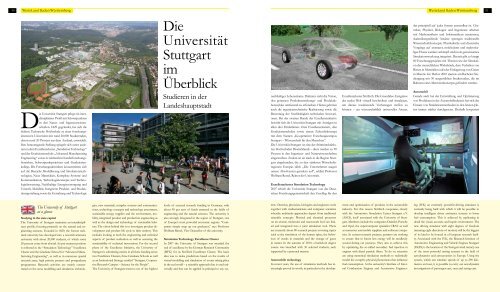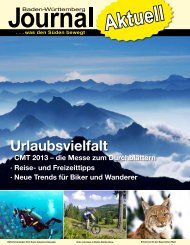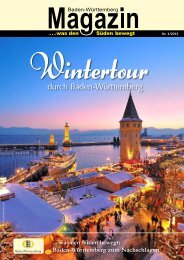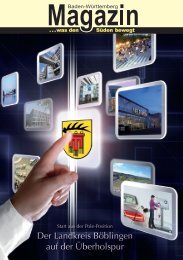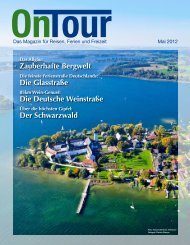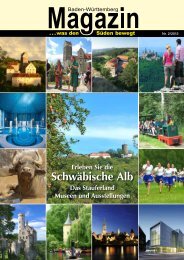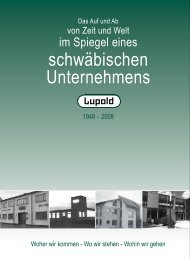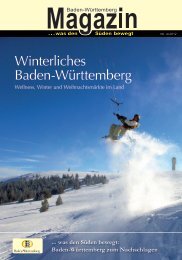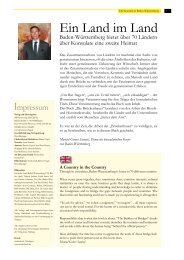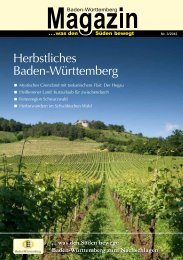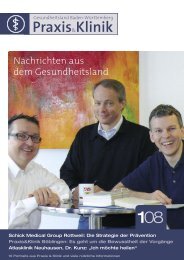WerteLand Baden-Württemberg - PR Presseverlag Süd GmbH
WerteLand Baden-Württemberg - PR Presseverlag Süd GmbH
WerteLand Baden-Württemberg - PR Presseverlag Süd GmbH
Erfolgreiche ePaper selbst erstellen
Machen Sie aus Ihren PDF Publikationen ein blätterbares Flipbook mit unserer einzigartigen Google optimierten e-Paper Software.
90 <strong>WerteLand</strong> <strong>Baden</strong>-<strong>Württemberg</strong><br />
Die Universität Stuttgart pflegt ein interdisziplinäres<br />
Profil mit Schwerpunkten<br />
in den Natur- und Ingenieurwissenschaften.<br />
1829 gegründet, hat sich die<br />
frühere Technische Hochschule zu einer forschungsintensiven<br />
Universität mit rund 20.000 Studierenden,<br />
davon rund 20 Prozent aus dem Ausland, entwickelt.<br />
Ihre herausragende Stellung spiegelt sich unter anderem<br />
in dem Exzellenzcluster „Simulation Technology“<br />
und der Graduiertenschule „Advanced Manufacturing<br />
Engineering“ sowie in zahlreichen Sonderforschungsbereichen,<br />
Schwerpunktprojekten und Graduiertenkollegs.<br />
Die Forschungsaktivitäten konzentrieren sich<br />
auf die Bereiche Modellierung und Simulationstechnologien,<br />
Neue Materialien, Komplexe Systeme und<br />
Kommunikation, Technologiekonzepte und Technologiebewertung,<br />
Nachhaltige Energieversorgung und<br />
Umwelt, Mobilität, Integrierte Produkt- und Produktionsgestaltung<br />
sowie die Gestaltung und Technologie<br />
The University of Stuttgart<br />
at a glance<br />
Studying in the state capital<br />
The University of Stuttgart maintains an interdisciplinary<br />
profile, focusing primarily on the natural and engineering<br />
sciences. Founded in 1829, the former technical<br />
university has developed into a research-intensive<br />
university with about 20,000 students, of which some<br />
20 percent come from abroad. Its pre-eminent position<br />
is reflected in the “Simulation Technology” Excellence<br />
Cluster and the Graduate School for “Advanced Manufacturing<br />
Engineering”, as well as in numerous special<br />
research areas, high priority projects and postgraduate<br />
programmes. Research activities are mainly concen-<br />
trated on the areas modelling and simulation technolo-<br />
gies, new materials, complex systems and communications,<br />
technology concepts and technology assessment,<br />
sustainable energy supplies and the environment, mobility,<br />
integrated product and production engineering as<br />
well as the design and technology of sustainable habitats.<br />
The vision behind this is to investigate product development<br />
and product life cycle in their entirety. This<br />
includes looking at both the engineering and technical<br />
aspects of product realisation as well as assessing the<br />
sustainability of technical innovations. For the second<br />
phase of the Excellence Initiative, the University of<br />
Stuttgart is submitting entries in all three funding areas:<br />
two Excellence Clusters, three Graduate Schools as well<br />
as an Institutional Strategy entitled “Stuttgart, Cooperative<br />
Research Campus – Science for the People”.<br />
The University of Stuttgart receives one of the highest<br />
Die<br />
Universität<br />
Stuttgart<br />
im<br />
Überblick<br />
Studieren in der<br />
Landeshauptstadt<br />
levels of external research funding in Germany, with<br />
about 90 per cent of funds attracted in the fields of<br />
engineering and the natural sciences. The university is<br />
also strongly integrated in the region of Stuttgart, one<br />
of Europe’s most powerful economic regions. “Companies<br />
simply snap up our graduates,” says Professor<br />
Wolfram Ressel, Vice Chancellor of the university.<br />
Simulation Technology Excellence Cluster<br />
In 2007 the University of Stuttgart was awarded the<br />
seal of excellence by the German Research Community<br />
(DFG) for its SimTech Excellence Cluster. The basic<br />
idea was to make predictions based on the results of<br />
virtual modelling and simulation of events taking place<br />
in the real world – a scientific approach that is used universally<br />
and that can be applied in principal to any sys-<br />
nachhaltiger Lebensräume. Dahinter steht die Vision,<br />
den gesamten Produktentstehungs- und Produktlebenszyklus<br />
umfassend zu erforschen. Hierzu gehören<br />
auch die ingenieurtechnische Realisierung sowie die<br />
Bewertung der Nachhaltigkeit technischer Innovationen.<br />
Bei der zweiten Runde der Exzellenzinitiative<br />
bewirbt sich die Universität Stuttgart mit Anträgen in<br />
allen drei Förderlinien: Zwei Exzellenzclustern, drei<br />
Graduiertenschulen sowie einem Zukunftskonzept<br />
mit dem Namen „Kooperativer Forschungscampus<br />
Stuttgart – Wissenschaft für den Menschen“.<br />
Die Universität Stuttgart ist eine der drittmittelstärksten<br />
Hochschulen Deutschlands – diese werden zu 90<br />
Prozent in den Ingenieur- und Naturwissenschaften<br />
eingeworben. Zudem ist sie stark in die Region Stuttgart<br />
eingebunden, die zu den stärksten Wirtschaftsregionen<br />
Europas zählt. „Die Unternehmen saugen<br />
unsere Absolventen geradezu auf“, erklärt Professor<br />
Wolfram Ressel, Rektor der Universität.<br />
Exzellenzcluster Simulation Technology<br />
2007 erhielt die Universität Stuttgart von der Deutschen<br />
Forschungsgemeinschaft den Zuschlag für den<br />
tem. Chemists, physicists, biologists and engineers work<br />
together with mathematicians and computer scientists<br />
whereby multiscale approaches depart from traditional<br />
scientific concepts. Physical and chemical processes<br />
on an atomic, molecular and macroscale level are link-<br />
ed and integrated into a joint simulation tool. There<br />
are currently about 80 research projects covering topics<br />
such as the simulation of the human spine, the behaviour<br />
of cracks in materials and the storage of gases<br />
in matter. In the autumn of 2010, a bachelor’s degree<br />
course was launched with 30 selected students, each<br />
supported by a personal mentor.<br />
Automobile technology<br />
In recent years, the use of simulation methods has increasingly<br />
proved its worth, in particular in the develop-<br />
Exzellenzcluster SimTech. Die Grundidee: Ereignisse<br />
der realen Welt virtuell beschreiben und simulieren,<br />
um daraus resultierende Vorhersagen treffen zu<br />
können – ein wissenschaftlich universeller Ansatz,<br />
ment and optimisation of products in the automobile<br />
industry. For this reason SimTech cooperates closely<br />
with the Automotive Simulation Center Stuttgart e.V.<br />
(ASCS), itself associated with the University of Stuttgart.<br />
Members include the companies Daimler, Porsche<br />
and Opel, the supercomputer specialist CRAY as well<br />
as numerous automobile suppliers and software companies.<br />
In current research projects, partners are working<br />
to ensure that in future less energy will be needlessly<br />
wasted during car journeys. They aim to achieve this<br />
by optimising the so-called secondary fuel injection in<br />
engines with diesel particle filters. To do so, scientists<br />
are using numerical simulation methods to realistically<br />
model the complex physical phenomena that influence<br />
fuel consumption. At the university’s Institute of Internal<br />
Combustion Engines and Automotive Engineer-<br />
<strong>WerteLand</strong> <strong>Baden</strong>-<strong>Württemberg</strong> 91<br />
der prinzipiell auf jedes System anwendbar ist. Chemiker,<br />
Physiker, Biologen und Ingenieure arbeiten<br />
mit Mathematikern und Informatikern zusammen,<br />
skalenübergreifende Ansätze sprengen traditionelle<br />
Wissenschaftskonzepte. Physikalische und chemische<br />
Vorgänge auf atomarer, molekularer und makroskaliger<br />
Ebene werden verknüpft und in ein gemeinsames<br />
Simulationswerkzeug integriert. Derzeit gibt es knapp<br />
80 Forschungsprojekte mit Themen wie der Simulation<br />
der menschlichen Wirbelsäule, dem Verhalten von<br />
Rissen in Materialien oder der Einlagerung von Gasen<br />
in Materie. Im Herbst 2010 startete ein Bachelor-Studiengang<br />
mit 30 ausgewählten Studierenden, die im<br />
Rahmen eines Mentorenkonzepts gefördert werden.<br />
Automobil<br />
Gerade auch bei der Entwicklung und Optimierung<br />
von Produkten in der Automobilindustrie hat sich der<br />
Einsatz von Simulationsmethoden in den letzten Jahren<br />
immer stärker durchgesetzt. Deshalb kooperiert<br />
ing (IVK) an extremely powerful driving simulator is<br />
currently being built with which it will be possible to<br />
develop intelligent driver assistance systems to lower<br />
fuel consumption. This is achieved by replicating in<br />
detail the visual, acoustic and haptic environment. The<br />
new driving simulator with eight degrees of freedom<br />
(meaning eight directions of motion) will be the biggest<br />
of its kind to be housed in a European research facility.<br />
Associated with the IVK, the Research Institute of<br />
Automotive Engineering and Vehicle Engines Stuttgart<br />
(FKFS) is the location of the Stuttgart wind tunnel, one<br />
of the most powerful testing systems in the field of<br />
aerodynamics and aeroacoustics in Europe. Using the<br />
system, which can simulate speeds of up to 290 kilometres<br />
an hour, it is possible to carry out aerodynamic<br />
investigations of passenger cars, vans and racing cars.


